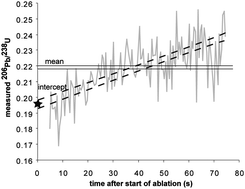Data acquisition and calculation of U–Pb isotopic analyses using laser ablation (single collector) inductively coupled plasma mass spectrometry†
Abstract

* Corresponding authors
a
Department of Earth Sciences, Memorial University of Newfoundland, St John's, Newfoundland, Canada
E-mail:
c.fisher@mun.ca
Fax: +1 709 737-4851
Tel: +1 709 737 4851
b
Natural Resources Canada, Geological Survey of Canada, Ottawa, Ontario, Canada
E-mail:
Simon.Jackson@NRCan-RNCan.gc.ca
Fax: +1 613 996 2301
Tel: +1 613 943 1286

 Please wait while we load your content...
Something went wrong. Try again?
Please wait while we load your content...
Something went wrong. Try again?
C. M. Fisher, H. P. Longerich, S. E. Jackson and J. M. Hanchar, J. Anal. At. Spectrom., 2010, 25, 1905 DOI: 10.1039/C004955G
To request permission to reproduce material from this article, please go to the Copyright Clearance Center request page.
If you are an author contributing to an RSC publication, you do not need to request permission provided correct acknowledgement is given.
If you are the author of this article, you do not need to request permission to reproduce figures and diagrams provided correct acknowledgement is given. If you want to reproduce the whole article in a third-party publication (excluding your thesis/dissertation for which permission is not required) please go to the Copyright Clearance Center request page.
Read more about how to correctly acknowledge RSC content.
 Fetching data from CrossRef.
Fetching data from CrossRef.
This may take some time to load.
Loading related content
